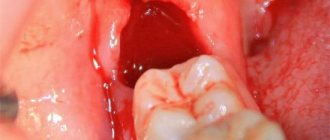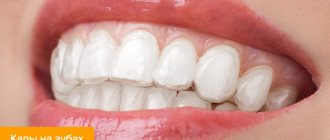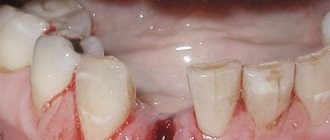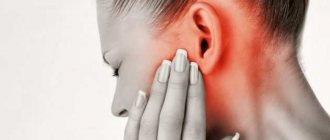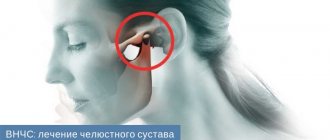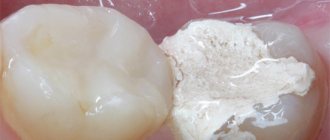Teeth hurt when you have a cold or runny nose: what to do if your jaw hurts
Toothache during a cold is quite common.
Moreover, those teeth that were previously completely healthy can suffer. Discomfort may also be observed in the gums, and the condition is accompanied by fever, cough and runny nose.
Why do teeth hurt when you have a cold? Most often, pain is explained by pressure generated in the maxillary sinuses.
Why do teeth hurt when you have a cold?
In addition to high sinus pressure, the causes of pain in the teeth and gums may be due to the following factors:
What to do to eliminate pain
If the cause of the pain is known, it is easier to find treatment methods.
The very first thing to do in case of severe pain is to take an analgesic. If the sensations do not disappear even after eliminating the cold, the patient should consult a dentist.
Tooth pain can develop due to inflammation of the trigeminal nerve. In such a situation, the following methods will help the patient:
- heating with electrophoresis;
- ultrasound and laser therapy;
- magnetic therapy;
- taking painkillers.
Traditional methods of treatment are often used for dental treatment.
Rinsing the mouth with soda solution. This measure will relieve inflammation from the gums and eliminate pain.
Typically, the basis of such drops is valerian and camphor. Both of these substances have a calming effect.
Lozenges of mint tablets will also help eliminate discomfort in the mouth during a cold. You need to put several pieces on your tongue at once, so the effect will come much faster.
A hot decoction of sage helps with toothache. The liquid is taken into the mouth and held for several minutes, then spat out.
Propolis is an effective remedy for toothache. This substance will not only eliminate pain, but will also prevent a purulent abscess.
It is impossible to get rid of acute pain using traditional medicine. Here a doctor will come to the patient’s aid, but usually the symptom disappears immediately after the cold is eliminated, that is, the cause of the discomfort in the teeth and gums.
As for colds, the video in this article will show you what to do at the first sign of a cold.
- Ears hurt when you have a cold: how to treat complications at home
- Headache due to sinusitis: what to do if you have a headache
- What to do with the flu if you get sick during an epidemic
I don’t know how it is with a cold, but when sinusitis worsens in spring and autumn, my teeth constantly hurt. To stay awake all night and suffer from terrible pain, just take a walk in the fresh air before bed.
Causes of toothache due to colds
18-10-2016
It’s mid-October, the first cold snap and now the cold season is in full swing. Unfortunately, a cold can cause toothache. Our body is a single whole. And a failure in one of the systems can lead to a number of other problems in other organs.
Causes of toothache due to a cold?
So, why do teeth hurt when you have a cold?
One of the symptoms of acute respiratory infections is nasal congestion . Phlegm clogs the nasal sinuses, increasing pressure in them, which also extends to the dentition. This is one of the most common causes of toothache during a cold. Rinse your nose often and use vasoconstrictor drops or sprays to make you feel better.
When, during a cold, we cannot breathe through a stuffy nose, we breathe through our mouth . Dry mouth can also be a cause of toothache, because with a lack of saliva, tooth sensitivity increases. Drink more liquid!
The inflammatory process that occurs in the body during a cold can affect the trigeminal nerve . Inflammation of the trigeminal nerve is accompanied by pain. In this case, a visit to the dentist is strictly necessary to examine the oral cavity and rule out dental disease.
In order for the cold to go away as unnoticed as possible for our well-being and as quickly as possible, we use all available cold remedies : drink drinks high in vitamin C, such as fruit drinks, take syrups (high in sugar), drink cold medications and influenza, which relieve symptoms (but they contain acids). All these efforts can also cause toothache, affecting the health of teeth and their sensitivity. After taking such products, it is very advisable to rinse your mouth.
If you are unlucky and vomiting and nausea , when it comes out, gastric juice also comes out, containing acids that damage the enamel, increase its sensitivity, which causes toothache. After this, be sure to rinse your mouth.
When you have a cold, don't forget to drink more and rinse your mouth often. Be sure to rinse your mouth after taking medications, as well as after fruit drinks and drinks with lemon. Toothache caused by a cold will most often go away along with the cold. If your cold is over and you still feel pain in your teeth, don’t put off visiting the dentist! Timely consultation with a doctor will help keep your teeth healthy for a long time.
News
30-12-2021
Opening hours on New Year's holidays
Dear patients! Please note that there are changes to our operating hours due to the New Year holidays. more details...
26-10-2021
Important information
from November 30 to November 7, the clinic will only accept patients for acute pain. more details...
19-10-2021
The clinic has a day off on November 4
Dear patients!
Please note: the clinic will not be open on November 4th. more details... All news
Teeth hurt when you have a cold or runny nose: what to do if your jaw hurts
Toothache during a cold is quite common.
Moreover, those teeth that were previously completely healthy can suffer. Discomfort may also be observed in the gums, and the condition is accompanied by fever, cough and runny nose.
Why do teeth hurt when you have a cold? Most often, pain is explained by pressure generated in the maxillary sinuses.
Why do teeth hurt when you have a cold?
In addition to high sinus pressure, the causes of pain in the teeth and gums may be due to the following factors:
What to do to eliminate pain
If the cause of the pain is known, it is easier to find treatment methods.
The very first thing to do in case of severe pain is to take an analgesic. If the sensations do not disappear even after eliminating the cold, the patient should consult a dentist.
Tooth pain can develop due to inflammation of the trigeminal nerve. In such a situation, the following methods will help the patient:
- heating with electrophoresis;
- ultrasound and laser therapy;
- magnetic therapy;
- taking painkillers.
Traditional methods of treatment are often used for dental treatment.
Rinsing the mouth with soda solution. This measure will relieve inflammation from the gums and eliminate pain.
Typically, the basis of such drops is valerian and camphor. Both of these substances have a calming effect.
Lozenges of mint tablets will also help eliminate discomfort in the mouth during a cold. You need to put several pieces on your tongue at once, so the effect will come much faster.
A hot decoction of sage helps with toothache. The liquid is taken into the mouth and held for several minutes, then spat out.
Propolis is an effective remedy for toothache. This substance will not only eliminate pain, but will also prevent a purulent abscess.
It is impossible to get rid of acute pain using traditional medicine. Here a doctor will come to the patient’s aid, but usually the symptom disappears immediately after the cold is eliminated, that is, the cause of the discomfort in the teeth and gums.
As for colds, the video in this article will show you what to do at the first sign of a cold.
- Ears hurt when you have a cold: how to treat complications at home
- Headache due to sinusitis: what to do if you have a headache
- What to do with the flu if you get sick during an epidemic
I don’t know how it is with a cold, but when sinusitis worsens in spring and autumn, my teeth constantly hurt. To stay awake all night and suffer from terrible pain, just take a walk in the fresh air before bed.
Causes of pain in the nose and head
Pain in the nose that radiates to the head is the result of a number of pathological processes. They can be associated with internal or external factors that cause inflammation of the nasal structures or disruption of their anatomical integrity. Based on the exact location of the painful focus, its cause can be assumed. According to the mechanism of development, several main groups of diseases are distinguished:
- inflammatory processes - often occur with viral and bacterial diseases, but can also be associated with autoimmune processes and allergic reactions;
- injuries - accompanied by mechanical damage to the mucous membrane, skin and subcutaneous tissue, as well as cartilage tissue and other structures;
- Poor circulation in certain areas of the nose or nasopharynx is a less common cause of nasal pain and is associated with aseptic cell necrosis (death without the participation of pathogenic microflora).
Another classification distinguishes several groups of causes, depending on the location of the main cause of nasal pain. These include:
- diseases of the external nose - often represent damage to the skin and subcutaneous tissue (furuncle, carbuncle, erysipelas, eczema);
- diseases of the inner nose - can affect both the mucous membrane and bone and cartilage tissue, and also occur due to the ingress of foreign objects and injury to internal structures;
- diseases of the paranasal sinuses - represent a separate group of diseases that involve infection and inflammation of the mucous membrane;
- diseases that can simultaneously affect several structures of the nose - these include both viral and catarrhal rhinitis, as well as more dangerous pathologies (tuberculosis, granulomatosis).
It is important to determine the primary cause of nasal pain in order to select an effective treatment regimen. Doctors at the Clinical Institute of the Brain will make an accurate diagnosis in a short time, based on the results of the examination. Treatment tactics will differ for injuries, infectious diseases, allergic and autoimmune processes.
Rhinitis
One of the most common reasons why the nose and head hurt is rhinitis, or runny nose, inflammation of the nasal mucosa. It is a symptom of most colds caused by viruses and bacteria. Pathogenic microflora penetrates the nasal mucosa, where the main fight of the immune system against infection occurs. The process is accompanied by inflammation, redness and swelling of the mucous membrane, and increased secretion of exudate.
The main symptoms of rhinitis include:
- runny nose, nasal congestion – excessive exudation makes breathing difficult;
- pain in the nose - more often they are concentrated at the site of inflammation;
- headaches - occur due to difficulties with breathing, as well as as a result of deterioration in general well-being;
- itching and burning in the nose.
Treatment for rhinitis depends on its cause. If the disease is caused by a viral infection, it is important to strengthen the immune system and provide the patient with bed rest. To make breathing easier, the doctor will select medications in the form of nasal drops or spray. They contain anti-inflammatory and antiviral components, as well as substances that constrict blood vessels and reduce the appearance of a runny nose.
Sinusitis
Diseases of the paranasal sinuses can occur independently or as a complication of colds. Normally, paranasal sinuses are aseptic formations in which there is no pathogenic microflora. If viruses or bacteria penetrate the mucous membrane of the sinuses, inflammatory processes begin. The danger of the disease is that normally there is no fluid in the sinuses, so draining the exudate is difficult. The cavities can be filled with liquid contents or pus, depending on the cause and type of inflammation.
There are several main types of sinusitis, which develop in different paranasal sinuses:
- Sinusitis is inflammation of the maxillary (maxillary) sinuses. They are located to the left and right of the nasal cavity and connect to it. Sinusitis is the most common form of sinusitis, accompanied by pain in the nose, bridge of the nose and head.
- Frontitis is inflammation of the frontal sinuses. They are located above the nasal cavity, in the thickness of the frontal bone. They are paired, but connected to each other by a common partition. Frontal sinusitis is diagnosed less frequently than sinusitis, but is also a common type of sinusitis.
- Sphenoiditis is inflammation of the mucous membrane of the sphenoid sinuses, a rare pathology. These sinuses belong to the posterior ones and are located in the thickness of the sphenoid bone. Their lower wall is the upper arch of the inner nose. Despite the fact that sphenoiditis occurs rarely, it is considered a dangerous disease. This is due to the deep location of the sinuses, the difficulty of accessing them and difficult drainage of fluid.
- Ethmoiditis is inflammation of the mucous membrane of the ethmoid bone. Their number is not constant, in different people it can range from 8 to 10. The sinuses are cells of the ethmoid bone. Ethmoiditis rarely develops as an independent disease; it often accompanies other forms of inflammation of the paranasal sinuses.
A lingering runny nose, pain in the head and bridge of the nose, behind the eyes often indicates the onset of sinusitis. Other inflammatory diseases of the sinuses are diagnosed less frequently. It is useful to know about one characteristic symptom of sinusitis, with which the disease can be recognized even at home. To do this, you need to bend over sharply and lower your head to the ground. If at the same time acute pain begins in the nose and head, in the forehead and bridge of the nose, inflammation of the maxillary sinus can be assumed.
Treatment of sinusitis is prescribed individually. The most common method is nasal rinsing combined with a course of antibiotics. These drugs destroy bacterial microflora, thereby eliminating the symptoms of purulent inflammation. However, in acute forms of sinusitis, drainage of the maxillary sinuses may be necessary. The procedure consists of puncturing them, removing purulent contents and treating the mucous membrane with antiseptic solutions.
Injuries
One of the causes of pain in the nose and head is injury . Nasal fractures, damage to the nasal septum and other factors lead to disruption of tissue integrity and hemorrhages, deterioration of blood supply and innervation of certain areas. Injuries to the internal structures of the nose can also be caused by foreign bodies entering the nasal passages. The process is dangerous, since pathogenic microflora multiply in damaged areas, tissue suppuration and necrosis occur. In addition, if recovery is not performed correctly, the patient may find it difficult to breathe even after a long time.
Treatment for injuries is prescribed based on the results of the examination. If the bones and cartilage remain intact, and only damage to the skin, subcutaneous tissue and mucous membranes is detected, it is important to regularly treat these areas with antiseptics. In case of displaced fractures, an operation is prescribed, during which the bone fragments are returned to the anatomically correct position. With proper rehabilitation, breathing returns to normal without consequences.
Inflammatory diseases of the skin and subcutaneous tissue
Diseases of the skin and subcutaneous tissue can appear on both the outer and inner surfaces of the nose. They are often associated with the entry of pathogenic microflora and its reproduction in a favorable environment. In addition, inflammation develops as a result of microtraumas. There are several formations that can appear in different parts of the external nose, causing headaches and breathing problems.
- Furuncle - formed when the sebaceous gland is infected with staphylococci or streptococci. It is a small, painful raised area above the surface of the skin containing pus. Most often, boils appear on the skin, in the area of the tip or wings of the nose.
- A carbuncle is a larger formation that occurs when the sebaceous gland, one or more hair follicles are simultaneously infected. The process spreads to the skin, subcutaneous tissue and mucous membranes, causing their purulent melting. A carbuncle is a dense, painful formation of a red or bluish tint that causes acute pain and fever.
- Eczema is an allergic inflammation, but its exact cause has not been established. The skin of the tip and wings of the nose is often damaged. It becomes dry, turns red, cracks, ulcers and blisters filled with transparent aseptic content may appear on it. Due to a violation of its integrity, boils, carbuncles and other manifestations of skin suppuration may form in the affected areas.
- Erysipelas (erysipelas) is an infectious disease that affects the skin and subcutaneous tissue. It is caused by specific microorganisms, hemolytic streptococci. They cause inflammation, redness of the skin and subcutaneous tissue, as well as hardening of these structures. These areas are painful, and in many patients they are separated from the healthy skin of the nose by a noticeable ridge.
In infectious diseases, redness of the skin, swelling and an increase in local temperature are observed. Limited formations are less dangerous because the purulent contents are enclosed in a capsule. To get rid of them, a simple procedure is carried out in which the abscess is opened, cleaned and treated with antibiotic solutions. Diseases in which the pus is in a diffuse state require complex treatment using broad-spectrum antibacterial drugs.
Allergy
If your head and nose constantly hurt, or a chronic runny nose does not stop, this may be the first sign of an allergy. It is a pathological reaction of the immune system to various stimuli. If in a healthy person the immune factors react only to viruses and bacteria, then in an allergic person they react to any substances. Thus, dust and pollen, animal hair, household chemicals and dyes, and certain products often become allergens. When they enter the body, characteristic allergy symptoms appear:
- pressing headaches, dizziness;
- runny nose, difficulty breathing;
- deterioration in general health;
- swelling of the nasal mucosa;
- irritation and redness of the skin, itching, burning and rash.
At the first symptoms of an allergy, it is important to determine what caused it. The easiest way is to track what new substances the patient has been in contact with recently. Allergy tests are considered the most accurate method. Concentrated allergens are injected under the skin in the forearm and the reaction is observed for several days. If inflammation develops at the injection site and a painful swelling appears, it can be argued that this substance is an allergen. Antihistamines are used for treatment, which suppress the immune system's reactions.
A specific type of allergy is autoimmune reactions . They arise in response to internal factors and the body’s own tissues. Manifestations of these processes also include headaches, inflammatory reactions, damage to the skin and mucous membranes. Treatment is selected individually, its main stages are reducing the sensitivity of the immune system and anti-inflammatory therapy.
Herpes
Herpes is a viral disease with a chronic course. It can cause various diseases, including damage to the skin and mucous membranes. Small blisters form in the nose area, the skin becomes red and inflamed, and an itching and burning sensation appears. The bubbles are located close to each other, in a limited space. They open on their own, leaving behind small ulcers.
The herpes virus is present in the body of most people, but occurs in a latent form. An exacerbation is caused by a decrease in immunity, and therefore may be associated with colds. Antiviral and restorative drugs are used to treat it. However, after recovery, immunity is not formed. In addition, the virus continues to be present in the body, so another exacerbation can occur at any time.
Other reasons
The exact cause of the pain in the nose, which radiates to the head, can only be determined as a result of a complete examination. If viral rhinitis remains the most common diagnosis, then diagnostics may also reveal more rare and dangerous pathologies. To identify them, it is important to pay attention to all the signs and carry out the necessary tests.
The examination may reveal the following abnormalities:
- dental diseases (caries, abnormal growth and position of teeth);
- tuberculosis is a chronic disease caused by mycobacteria, which manifests itself, among other things, in the destruction of nasal structures and acute pain in the head;
- granulomatosis is a systemic autoimmune disease in which normal tissues are destroyed and replaced by dense connective tissue;
- neoplasms - can be found in any area;
- abnormalities in the structure of the nose, often manifested by a deviated nasal septum and difficulty breathing.
When diagnosing, the doctor takes into account all possible options, but is guided by the data of the examination and questioning of the patient. You should not be afraid of dangerous diseases if your complaints include a runny nose and headaches.
Toothache due to cold #8212; Why does my jaw hurt so bad and my temples ache?
Compared to it, other symptoms of ARVI become unnoticeable factors. The patient is constantly looking for ways and methods to get rid of toothache. Let’s figure out why when you have a cold, your teeth often hurt, your jaw ache, and your gums ache, and we’ll also find out what you can do at home to relieve pain and improve the general condition of the body.
Where to look for the roots of the problem?
Typically, toothache during a cold is a collateral deviation in the functioning of the body and is not something special.
But the reasons may be completely different, which few people think about:
- Insufficient oral hygiene . The patient, due to weakness, fever and chills, gets out of bed only when absolutely necessary. People stop paying attention to such necessities as rinsing the mouth after eating and brushing their teeth. In this condition the teeth
When there is a river of snot and a fever, there is no time for oral hygiene#8230;
In this case, the situation can be corrected without outside help. It is necessary, no matter what, to carry out oral hygiene procedures.
You also need to control the amount of aggressive substances entering the body and gradually destroying healthy teeth. Food should not contain sour, cold, hot, spicy or too sweet ingredients.
How can this be unpleasant and dangerous?
If the respiratory process is accompanied by painful aching sensations in the gums and teeth, this may indicate the emergence of health-hazardous conditions. They may be:
To identify the exact cause, you need to seek help from specialists. In such cases, you cannot self-medicate at home. This can lead to serious consequences. Sinusitis, for example, can progress to a stage where surgical intervention is indispensable.
How does it feel?
It is known that patients with a cold infection may experience both mild and acute pain in the teeth, jaw and gums.
Toothache during a cold: causes and treatment
One of the symptoms of a common cold, along with high fever, runny nose and cough, can be toothache. Teeth that are completely healthy at first glance can turn out to be a source of pain and signal problems with the body. When a toothache occurs due to a cold, adequate treatment prescribed by a general practitioner can quickly relieve you of this unpleasant symptom.
Why does toothache occur with a cold?
Toothache, along with headache and earache, can be a symptom of a cold. It occurs most often due to such a phenomenon as the occurrence of excess pressure in the nasal sinuses. When you have a cold, your sinuses become inflamed, and the mucus that forms in them blocks the passage, creating pressure that leads to pain. As soon as the inflammation of the mucous membrane is relieved, the teeth stop hurting. In addition, when we have a cold, we often drink a lot of liquids that contain acid. It can have a harmful effect on tooth enamel and cause pain. Also, when we have a runny nose, the mucous membrane of our mouth dries out quite noticeably, and the sugar that lingers on it in this way can also negatively affect the teeth.
Toothache due to a cold: treatment
So, we have looked at the main reasons why toothache most often occurs during a cold. Treatment prescribed by a therapist will help you recover as quickly as possible, and therefore get rid of painful sensations in your mouth. In the meantime, while the healing process is underway, you can relieve toothache using one of the proven home remedies.
- Rinsing with a baking soda solution (1 small spoon per glass of warm water) will help relieve inflammation and reduce irritation in the mouth. To achieve maximum effect, it is best to rinse your mouth 2-3 times an hour until signs of improvement appear.
- Dental drops. They can be purchased at any pharmacy for a small price. These drops have a calming effect and are based on camphor and valerian. It is enough to apply a few drops on a cotton swab and apply to the aching area.
- Sage decoction. Keep the warm sage decoction in your mouth for a few minutes, and you will notice that your toothache will become much less intense.
- Painkillers. If toothache causes you a lot of problems during a cold, then you can use any of the painkillers: ibuprofen, paracetamol, etc. The main thing is that the benefits of their use outweigh the harm they can cause to your liver and the entire body as a whole.
You can get a consultation at the DENTISTRY clinic. Make an appointment by calling +7 (8342) 308–088 or using the form below.
Make an appointment
Why do teeth hurt when you have a cold?
The causes of toothache are divided into 2 groups: caused by a cold, due to an exacerbation of a chronic disease or its manifestation due to a weakened immune system.
Teeth hurt when you have a cold due to:
- increased pressure on dentin due to the accumulation of mucous secretions and poor circulation in the respiratory tract - the tooth root begins to ache, and when opening the mouth, there is pain in the chin;
- an increase in the volume of the thyroid gland - a dull pain covers the jaw, after 30-40 minutes it intensifies in the frontal area, slight numbness of the jaw;
- tonsillitis (inflammation covers all the nerve endings of the teeth) - swelling of the gums, suppuration in the dentin, unstable pain. Changes in temperature in the oral cavity cause severe twitching pain, which is replaced by an unbearable dull pain;
- rhinitis, caused by a cold, is an inflammatory process that covers the bridge of the nose, the frontal bone, and after 2-3 days the pain covers the jaw.
Causes of toothache due to decreased immunity caused by a cold:
- Exacerbation of chronic herpes, periodically manifested stomatitis: aching in the jaws begins when the temperature rises to 38.5-40 degrees. Necessarily bad breath, with a sore throat - ear inflammation. flu - teeth and stomach start to hurt at the same time.
- Immune diseases of bone tissue: pain begins near the ears, itching in the auricles and middle ear. After a few hours, there is a crunching sound when opening the mouth, severe pain radiates into the eyes, and when biting, it shoots into the head.
- Autoimmune: burning gums, pain affects the entire oral cavity.
- Gastrointestinal tract: unpleasant odor, mucus on the gums, constant boring mild pain.
- Periodic nervousness: strong, stable, circles before the eyes may be accompanied by fainting. There is an increase in blood pressure, intracranial pressure rises at night or in bright light. Teeth ache when exposed to irritating sounds.
Reference! If the enamel is not damaged, regardless of the etiology of the disease, teeth never react to sour, sweet, or changes in temperature. With rhinitis, a headache precedes a toothache.
First aid: what to do if your teeth hurt
Rinse your mouth with soda solution. If the pain is concentrated in one area, apply honey and alcohol to the gum (for 2 tablespoons of hot honey, 1 teaspoon of alcohol). Do not hold for more than 30 seconds. Rinse your mouth with chamomile decoction: 1.5 tsp per 200 ml of boiling water. daisies. Boil for 2-3 minutes. Strain and let cool.
If you have aching jaws, heat the salt. Wrap with a linen towel several times. Place under your cheek. Change position every 5-7 minutes.
If the enamel is damaged, rinse with boiled, settled water or add 1 tbsp per 200 ml. l. aloe juice Strictly prohibited: salt, soda, acetic and citric acid. Rinse only as directed by a doctor.
For immune and autoimmune diseases, you can use medications as prescribed by your doctor. Folk remedies aggravate the course of the disease and favor the crumbling of bone tissue. For autoimmune diseases, rowan, pomegranate and carrot juice are strictly prohibited. The pain goes away, immunity increases, but the disease worsens. Teeth may begin to fall out.
After cancer, rinse with water and beet juice in a ratio of 1:1. If there is a putrid smell - 1 tbsp per 200 g of mixture. l. garlic juice or 200 ml of boiling water, 1 tbsp. l. chamomile, calendula and valerian. Boil in a water bath for 3 minutes. Do not use the decoction for more than 12 hours.
In case of suppuration, rinse your mouth with boiled water before using rinse solutions. Herbs and alcohol thicken the pus. It remains in the tissues.
For bone tissue diseases, use non-concentrated decoctions, do not use alcohol tinctures, or decoctions containing herbs that have a drying effect. An infusion of chamomile is desirable.
How to treat toothache
If your teeth begin to react painfully to a cold, consult a doctor as soon as possible! Perhaps a toothache combined with a cold poses the threat of a more serious illness!
To begin treatment for the disease as soon as possible, consult a therapist. If you start with the dentist, you will spend several days redirecting for additional tests, or highly specialized treatment will be prescribed, without taking into account the cause and consequences of the cold. Only the therapist has the opportunity to refer patients to all laboratory and instrumental examinations carried out in this clinic.
If negative sensations do not go away during treatment, you should contact your dentist and get tested for tumor markers. Aches in the jaws can be the result of inflammation of the soft tissues of the cervical spine, displacement of a vertebra, compression of muscles or nerves, or suppuration near them. Also, periodic inflammation of the middle ear provokes pinched nerve endings - shooting pain from the head to the tooth.
Before you start treating toothache during a cold, you should take into account that during a cold, microelements are washed out of the bone tissue, and tooth enamel becomes more fragile.
Medicines
Medications act faster than traditional medicine, but have a lot of side effects, often cause allergies, reduce immunity - accelerating the development of colds and increasing the risk of complications.
Causes
The TMJ connects the lower jaw and the temporal bone of the skull. This is a very mobile joint, actively moving during speech, chewing, swallowing, and if its normal functioning is difficult, then the person’s quality of life suffers significantly. The tissues surrounding the joint have many nerve endings, and even minor disturbances in the functioning of the TMJ lead to discomfort, pain and deterioration in the general condition of a person. A complete clinical and instrumental examination will allow us to find out the exact cause of the pain and differentiate the pathology from other problems in the maxillofacial area.
Prevention
Prevention consists of preventing colds and preserving the integrity of tooth enamel:
- Do not brush your teeth with toothpastes containing sodium lauryl sulfate - fluoride compounds, which are part of tooth enamel, are destroyed.
- In winter, try to eat fresh vegetables and fruits grown in a greenhouse, preferably with organic fertilizers.
- Do not alternate hot and cold foods.
- Harden the body with a gradual decrease in temperature.
- Visit the dentist at least 2 times a year.
Why do teeth hurt and gums become inflamed during colds, flu and ARVI, how to treat the oral cavity?
Many patients are faced with the fact that during the flu or ARVI, not only their throat and head hurt, but also their teeth, gums or cheekbones (see also: what to do if your cheekbone hurts when chewing near your ear?). Why does this symptom occur? Most often, discomfort is caused by pressure arising in the maxillary sinuses, as well as the active proliferation of bacteria in the mouth. If your teeth hurt due to a cold, they usually do not need to be treated - the discomfort will go away after recovery. However, sometimes pain in the teeth and gums can be a complication of a serious disease that cannot be treated at home.
Treatment of pain in the head and nose
Treatment tactics are selected individually, depending on the exact diagnosis and the nature of the disease. Most diseases can be treated with medication, but in some cases surgery is necessary. The course may include the following stages:
- taking antibiotics is a mandatory measure for bacterial diseases, purulent inflammation, injuries, sinusitis;
- supportive treatment, which includes anti-inflammatory and vasoconstrictor drugs, antipyretics and analgesics;
- antiviral drugs;
- surgical treatment - consists of opening and washing abscesses, boils, as well as sanitizing the paranasal sinuses for sinusitis.
Doctors at the Clinical Institute of the Brain will select the most effective treatment regimen, which will include only the necessary steps. The drugs can be taken on schedule at home, only in some cases treatment in a hospital is indicated. The patient remains to follow all recommendations and regularly return for re-examination.
Pain in the jaw due to ARVI
Inflammation of the trigeminal nerve
Toothache during a cold can be a consequence of inflammation of the trigeminal nerve (see also: what to do if the dental nerve has caught a cold?). This disease develops due to a viral infection and inflammation in the jaw joint. The infection that penetrates the nerve and plexus of blood vessels quickly spreads and sometimes makes the whole face hurt.
The patient feels that his jaw is aching and his teeth hurt on the side where the inflammation develops (we recommend reading: which doctor to see and what to do if your jaw hurts?). The disease is accompanied by slightly noticeable swelling of the face, and when trying to yawn or swallow food, the person feels severe discomfort.
What to do to reduce pain? It is worth remembering that you cannot self-medicate. Using a heating pad at home is strictly prohibited - improper heating of soft tissues can aggravate the inflammatory process and pain. In addition, discomfort in the cheekbones and teeth can be caused by otitis media or inflammation of the articular sac of the lower jaw, and not the nerve. In these cases, diagnosis and treatment is carried out by an ENT specialist, not a neurologist.
If there is an inflammatory process in the trigeminal nerve, the specialist will prescribe anti-inflammatory drugs and antibiotics. One of the commonly used drugs for this diagnosis is Carbamazepine. Physiotherapy is also used for treatment: electrophoresis, ultrasound and magnetic therapy.
There are several methods to reduce dental discomfort due to inflammation of the trigeminal nerve:
- use dental drops purchased at a pharmacy;
- suck mints;
- chew a piece of propolis or apply it to the gum;
- Take a little hot sage decoction into your mouth and hold it on the side where the tooth aches.
What if it’s sinusitis?
In some cases, a cold or flu can cause a serious complication in the form of sinusitis. The maxillary sinuses are located next to the upper jaw, and many people have teeth quite close to them. Due to the development of the disease and the concentration of fluid with pus in the sinuses, pressure on the bone increases, causing pain in the oral cavity. Sometimes sinusitis provokes pain in the temples, cheekbones, the pain spreads to the entire upper jaw and intensifies when the head is tilted.
Severe inflammation in the maxillary sinuses can lead to the formation of bags of pus on the gums or an abscess and cyst on the root of the tooth. Then the patient will need treatment aimed at eliminating the underlying disease and the complications caused by it. As a rule, the patient is prescribed antibiotics and physiotherapy, and then he is sent to the dentist for further treatment.
For extremely advanced sinusitis, a specialist uses a puncture. The sinus is pierced, after which the accumulated fluid, which is a source of infection, is washed out of it. A complete cure will require from 3 to 10 procedures.
To ease breathing, vasoconstrictor drops are used for 5–7 days, as well as drugs that thin the mucus in the nose. Sinupret, a product based on natural ingredients, is often used in therapy.

